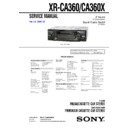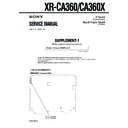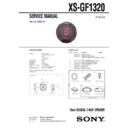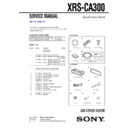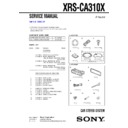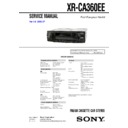Sony XR-CA360 / XR-CA360X / XRS-CA300 / XRS-CA310X Service Manual ▷ View online
SERVICE MANUAL
E model
FM/AM/CASSETTE CAR STEREO
Saudi Arabia model
FM/MW/SW CASSETTE CAR STEREO
E Model
XR-CA360/CA360X
Saudi Arabia Model
XR-CA360
SPECIFICATIONS
XR-CA360/CA360X
Photo: XR-CA360
Ver 1.2 2003.12
CA
9-874-258-03
Sony Corporation
2003L05-1
e Vehicle Company
C
2003.12
Published by Sony Engineering Corporation
Model Name Using Similar Mechanism
NEW
Tape Transport Mechanism Type
MG-36SZ13-32
Cassette player section
Tape track
4-track 2-channel stereo
Wow and flutter
0.13 % (WRMS)
Frequency response
30 – 15,000 Hz
Signal-to-noise ratio
55 dB
Tuner section
FM
Tuning range
(E model)
(E model)
FM tuning interval:
50 kHz/200 kHz
switchable
87.5 – 108.0 MHz
(at 50 kHz step)
87.5 – 107.9 MHz
(at 200 kHz step)
50 kHz/200 kHz
switchable
87.5 – 108.0 MHz
(at 50 kHz step)
87.5 – 107.9 MHz
(at 200 kHz step)
Aerial terminal
External aerial connector
Intermediate frequency
10.7 MHz/450 kHz
Usable sensitivity
9 dBf
Selectivity
75 dB at 400 kHz
Signal-to-noise ratio
67 dB (stereo),
69 dB (mono)
69 dB (mono)
Harmonic distortion at 1 kHz
0.5 % (stereo),
0.3 % (mono)
0.3 % (mono)
Separation
35 dB at 1 kHz
Frequency response
30 – 15,000 Hz
AM (E model)
Tuning range
AM tuning interval:
9 kHz/10 kHz switchable
531 – 1,602 kHz
(at 9 kHz step)
530 – 1,710 kHz
(at 10 kHz step)
9 kHz/10 kHz switchable
531 – 1,602 kHz
(at 9 kHz step)
530 – 1,710 kHz
(at 10 kHz step)
Aerial terminal
External aerial connector
Intermediate frequency
10.7 MHz/450 kHz
Sensitivity
30
µ
V
Power amplifier section
Outputs
Speaker outputs
(sure seal connectors)
(sure seal connectors)
Speaker impedance
4 – 8 ohms
Maximum power output 45 W
×
4 (at 4 ohms)
General
Outputs
Audio output
Power aerial relay control
lead
Power amplifier control
lead
Power aerial relay control
lead
Power amplifier control
lead
Inputs
BUS control input terminal
BUS audio input terminal
BUS audio input terminal
Tone controls
Low:
±
10 dB at 60 Hz (Xplod)
Mid:
±
10 dB at 1 kHz (Xplod)
High:
±
10 dB at 10 kHz (Xplod)
Power requirements
12 V DC car battery
(negative earth)
(negative earth)
Dimensions
Approx. 178
×
50
×
178 mm
(w/h/d)
Mounting dimensions
Approx. 182
×
53
×
161 mm
(w/h/d)
Mass
Approx. 1.2 kg
Supplied accessories
Parts for installation and
connections (1 set)
Front panel case (1)
connections (1 set)
Front panel case (1)
Design and specifications are subject to change
without notice.
without notice.
Tuning range
(Saudi Arabia model)
(Saudi Arabia model)
87.5 – 108.0 MHz
MW/SW (Saudi Arabia model)
Tuning range
MW: 531 – 1,602 kHz
SW1: 2,940 – 7,735 kHz
SW2: 9,500 – 18,135 kHz
(except for 10,140 – 11,575
kHz)
SW1: 2,940 – 7,735 kHz
SW2: 9,500 – 18,135 kHz
(except for 10,140 – 11,575
kHz)
Aerial terminal
External aerial connector
Intermediate frequency
10.7 MHz/450 kHz
Sensitivity
30
µ
V
2
XR-CA360/CA360X
Flexible Circuit Board Repairing
• Keep the temperature of the soldering iron around 270 ˚C dur-
ing repairing.
• Do not touch the soldering iron on the same conductor of the
circuit board (within 3 times).
• Be careful not to apply force on the conductor when soldering
or unsoldering.
Notes on chip component replacement
• Never reuse a disconnected chip component.
• Notice that the minus side of a tantalum capacitor may be dam-
• Notice that the minus side of a tantalum capacitor may be dam-
aged by heat.
TABLE OF CONTENTS
SERVICING NOTES
.........................................................
2
1.
GENERAL
Location of Controls .......................................................
3
Setting the Clock .............................................................
3
2.
DISASSEMBLY
2-1. Disassembly Flow ...........................................................
7
2-2. Sub Panel .........................................................................
7
2-3. Mechanism Deck (MG-36SZ13-32) ...............................
8
2-4. MAIN Board ...................................................................
8
2-5. Heat Sink .........................................................................
9
2-6. Bracket (MD) ..................................................................
9
2-7. DC Motor (Capstan/Reel) (M901) ................................. 10
2-8. Main Belt, Sub Belt (C) .................................................. 10
2-9. Magnetic Head (Playback) (HP901) .............................. 11
2-8. Main Belt, Sub Belt (C) .................................................. 10
2-9. Magnetic Head (Playback) (HP901) .............................. 11
3.
MECHANICAL ADJUSTMENTS
....................... 12
4.
ELECTRICAL ADJUSTMENTS
Tape Deck Section .......................................................... 12
Tuner Section .................................................................. 13
Tuner Section .................................................................. 13
5.
DIAGRAMS
5-1. Note for Printed Wiring Boards and
Schematic Diagrams ....................................................... 14
5-2. Printed Wiring Board – MAIN Board – ........................ 15
5-3. Schematic Diagram – MAIN Board (1/2) – .................. 16
5-4. Schematic Diagram – MAIN Board (2/2) – .................. 17
5-5. Printed Wiring Board – CONTROL Board – ................ 18
5-6. Schematic Diagram – CONTROL Board – ................... 19
5-7. IC Pin Function Description ........................................... 21
5-3. Schematic Diagram – MAIN Board (1/2) – .................. 16
5-4. Schematic Diagram – MAIN Board (2/2) – .................. 17
5-5. Printed Wiring Board – CONTROL Board – ................ 18
5-6. Schematic Diagram – CONTROL Board – ................... 19
5-7. IC Pin Function Description ........................................... 21
6.
EXPLODED VIEWS
6-1. General Section ............................................................... 23
6-2. Front Panel Section ......................................................... 24
6-3. MAIN Board Section ...................................................... 25
6-4. Mechanism Deck Section (MG-36SZ13-32) ................. 26
6-2. Front Panel Section ......................................................... 24
6-3. MAIN Board Section ...................................................... 25
6-4. Mechanism Deck Section (MG-36SZ13-32) ................. 26
7.
ELECTRICAL PARTS LIST
............................... 27
SERVICING NOTES
SERVICE POSITION
In checking the control board and main board, prepare two jigs
(extension (MD) cord J-2502-060-1 and
connection cable for F/P to main J-2502-072-1).
(extension (MD) cord J-2502-060-1 and
connection cable for F/P to main J-2502-072-1).
Note of replacing of the IC1
In this set, the IC1 on the MAIN board is changed from the mid-
way of the production.
When the replacing of the IC1, be sure to check the model name
printed by IC, and replace the IC1 by following the instructions
below.
way of the production.
When the replacing of the IC1, be sure to check the model name
printed by IC, and replace the IC1 by following the instructions
below.
• When replacing of the IC1 (MN101C49HAS)
Replace the IC1 with the MN101C49HEA (Part No.: 6-603-
178-01), and replace the TU101 (A-3220-944-A) simultaneously.
178-01), and replace the TU101 (A-3220-944-A) simultaneously.
• When replacing of the IC1 (MN101C49HEA)
Perform the usual replacing.
main board
(CN600)
(CN600)
mechanism deck
main board (CN350)
main board (CN300)
control board (CN900)
connect jig
(connection cable
for F/P to main J-2502-072-1)
to the main board (CN600) and
control board (CN900).
(connection cable
for F/P to main J-2502-072-1)
to the main board (CN600) and
control board (CN900).
connect jig
(extention (MD) cord J-2502-060-1)
to the main board (CN300, CN350)
and mechanism deck.
(extention (MD) cord J-2502-060-1)
to the main board (CN300, CN350)
and mechanism deck.
Ver 1.2
3
XR-CA360/CA360X
SECTION 1
GENERAL
This section is extracted from
instruction manual.
instruction manual.
Location of controls
XR-CA360X/CA360
SOURCE
MODE
SEL
RELEASE
EQ3
DSPL
ATT
DISC
REP
SHUF
ATA
1
2
3
4
5
6
BTM
OFF
SENS
SEEK
DIR
Refer to the pages listed for details.
1 SOURCE (Radio/CD/MD) button
2 MODE button
During radio reception:
Band select
During CD/MD playback:
CD/MD unit select
3 Volume +/– button
4 Z (eject) button
5 Display window
6 m/M (fast winding)/DIR (tape
transport direction change) buttons
7 SEEK button
Seek
Automatic Music Sensor
Manual search
Automatic Music Sensor
Manual search
8 DSPL (display mode change) button
9 EQ3 button
0 RELEASE (front panel release) button
qa SEL (select) button
qs RESET button (located on the front side
of the unit behind the front panel)
qd ATT (attenuate) button
qf Number buttons
During radio reception:
Preset number select
During CD/MD playback:
(1) DISC –
(2) DISC +
(3) REP
(4) SHUF
(2) DISC +
(3) REP
(4) SHUF
qg Frequency select switch (E model)
(located on the bottom of the unit)
See “Frequency select switch” in the
Installation/Connections manual.
See “Frequency select switch” in the
Installation/Connections manual.
qh BTM/ATA button
qj SENS button
qk OFF button*
* Warning when installing in a car
without ACC (accessory) position on
the ignition key switch
Be sure to press (OFF) on the unit for 2
seconds to turn off the clock display after
turning off the engine.
When you press (OFF) momentarily, the
clock display does not turn off and this
causes battery wear.
the ignition key switch
Be sure to press (OFF) on the unit for 2
seconds to turn off the clock display after
turning off the engine.
When you press (OFF) momentarily, the
clock display does not turn off and this
causes battery wear.
Setting the clock
The clock uses a 12-hour digital indication.
Example: To set the clock to 10:08
1
Press (DSPL) for 2 seconds.
The hour indication flashes.
1
Press either side of the volume button
to set the hour.
2
Press (SEL).
The minute indication flashes.
3
Press either side of the volume button
to set the minute.
to set the minute.
2
Press (DSPL).
The clock starts.
After the clock setting is complete, the
display returns to normal play mode.
display returns to normal play mode.
to go forward
to go back
to go forward
to go back
4
XR-CA360/CA360X
B
A
BUS AUDIO IN
BUS CONTROL IN
AUDIO OUT
REAR
BUS AUDIO IN
BUS CONTROL IN
Source selector*
Selector de fuente*
Selector de fuente*
XA-CA30
* not supplied
no suministrado
2
Cautions
•This unit is designed for negative earth 12 V DC
operation only.
•Do not get the wires under a screw, or caught in
moving parts (e.g. seat railing).
•Before making connections, turn the car ignition
off to avoid short circuits.
•Connect the yellow and red power input leads
only after all other leads have been connected.
•Run all earth wires to a common earth point.
•Be sure to insulate any loose unconnected wires
•Be sure to insulate any loose unconnected wires
with electrical tape for safety.
Notes on the power supply cord (yellow)
•When connecting this unit in combination with
•When connecting this unit in combination with
other stereo components, the connected car
circuit’s rating must be higher than the sum of
each component’s fuse.
circuit’s rating must be higher than the sum of
each component’s fuse.
•When no car circuits are rated high enough,
connect the unit directly to the battery.
Parts Iist (1)
•The numbers in the list are keyed to those in the
instructions.
•The bracket 1 and the protection collar 5 are
attached to the unit before shipping. Before
mounting the unit, use the release keys 7 to
remove the bracket 1 and the protection collar
5
mounting the unit, use the release keys 7 to
remove the bracket 1 and the protection collar
5
from the unit. For details, see “Removing the
protection collar and the bracket (4)” on the
reverse side of the sheet.
reverse side of the sheet.
•Keep the release keys 7 for future use as they
are also necessary if you remove the unit from
your car.
your car.
Caution
Handle the bracket 1 carefully to avoid injuring
your fingers.
your fingers.
Note
Before installing, make sure that the catches on both
sides of the bracket 1 are bent inwards 2 mm. If the
catches are straight or bent outwards, the unit will not
be installed securely and may spring out.
Before installing, make sure that the catches on both
sides of the bracket 1 are bent inwards 2 mm. If the
catches are straight or bent outwards, the unit will not
be installed securely and may spring out.
Connection example (2)
Notes (2-B-
)
• Be sure to connect the earth cord before connecting
the amplifier.
• If you connect an optional power amplifier and do
not use the built-in amplifier, the beep sound will be
deactivated.
deactivated.
Tip (2-B-
)
For connecting two or more CD/MD changers, the
source selector XA-C30 (optional) is necessary.
source selector XA-C30 (optional) is necessary.
Connection diagram (3)
1
To a metal surface of the car
First connect the black earth lead, then connect the
yellow and red power input leads.
First connect the black earth lead, then connect the
yellow and red power input leads.
2
To the power aerial control lead or power supply
lead of aerial booster amplifier
Notes
• It is not necessary to connect this lead if there is no
lead of aerial booster amplifier
Notes
• It is not necessary to connect this lead if there is no
power aerial or aerial booster, or with a manually-
operated telescopic aerial.
operated telescopic aerial.
• When your car has a built-in FM/AM aerial in the
rear/side glass, see “Notes on the control and
power supply leads.”
power supply leads.”
3
To AMP REMOTE IN of an optional power amplifier
This connection is only for amplifiers. Connecting
any other system may damage the unit.
This connection is only for amplifiers. Connecting
any other system may damage the unit.
4
To the +12 V power terminal which is energised in
the accessory position of the ignition key switch
Notes
• If there is no accessory position, connect to the +12
the accessory position of the ignition key switch
Notes
• If there is no accessory position, connect to the +12
V power (battery) terminal which is energised at
all times.
Be sure to connect the black ground lead to a
metal surface of the car first.
all times.
Be sure to connect the black ground lead to a
metal surface of the car first.
• When your car has a built-in FM/AM aerial in the
rear/side glass, see “Notes on the control and
power supply leads.”
power supply leads.”
5
To the +12 V power terminal which is energised at
all times
Be sure to connect the black ground lead to a metal
surface of the car first.
all times
Be sure to connect the black ground lead to a metal
surface of the car first.
1
Catch
Notes on the control and power supply leads
• The power aerial control lead (blue) supplies +12 V
• The power aerial control lead (blue) supplies +12 V
DC when you turn on the tuner.
• When your car has built-in FM/AM aerial in the rear/
side glass, connect the power aerial control lead
(blue) or the accessory power input lead (red) to the
power terminal of the existing aerial booster. For
details, consult your dealer.
(blue) or the accessory power input lead (red) to the
power terminal of the existing aerial booster. For
details, consult your dealer.
• A power aerial without relay box cannot be used with
this unit.
Memory hold connection
When the yellow power input lead is connected, power
will always be supplied to the memory circuit even
when the ignition key is turned off.
When the yellow power input lead is connected, power
will always be supplied to the memory circuit even
when the ignition key is turned off.
Notes on speaker connection
• Before connecting the speakers, turn the unit off.
• Use speakers with an impedance of 4 to 8 ohms, and
• Before connecting the speakers, turn the unit off.
• Use speakers with an impedance of 4 to 8 ohms, and
with adequate power handling capacities to avoid its
damage.
damage.
• Do not connect the speaker terminals to the car
chassis, or connect the terminals of the right speakers
with those of the left speaker.
with those of the left speaker.
• Do not connect the earth lead of this unit to the
negative (–) terminal of the speaker.
• Do not attempt to connect the speakers in parallel.
• Connect only passive speakers. Connecting active
• Connect only passive speakers. Connecting active
speakers (with built-in amplifiers) to the speaker
terminals may damage the unit.
terminals may damage the unit.
• To avoid a malfunction, do not use the built-in
speaker wires installed in your car if the unit shares a
common negative (–) lead for the right and left
speakers.
common negative (–) lead for the right and left
speakers.
• Do not connect the unit’s speaker cords to each other.

